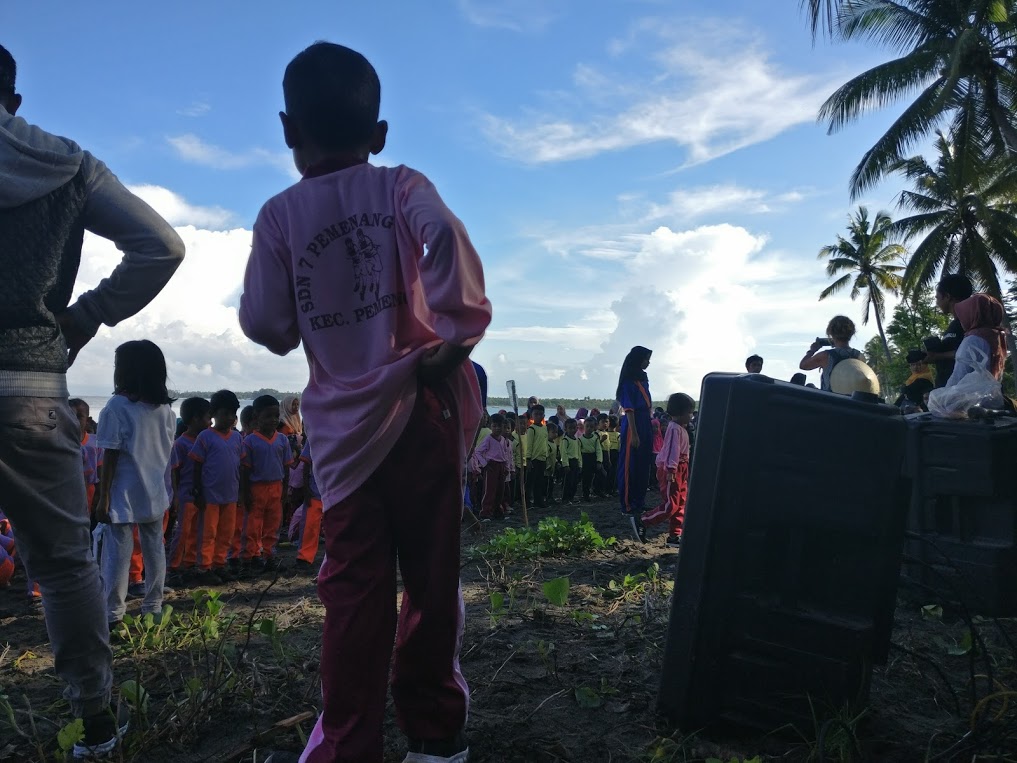
Kebersamaan
We sit at the end of the pier. Waves ripple below us. Occasionally, a scooter buzzes across the nearby Bangsal harbour. It’s dark. The mountain and the ocean feel close. Entranced, like me, they lean forwards, listening to Mintarja’s story.
Mintarja started talking after I offered him a lighter. I hadn’t joined one of the three prayer circles that had just formed. Instead, I walked to the end of the pier. There was a muffled exchange of voices. It hushed as I got near. Hey, whispered Maria, what are you doing? Ok, sit down. And be quiet! And as you’re here, take photos when we blow into the trumpet.
The first time the festival was held, Mintarja tells me, summoning memories, he’d made a berugaq, a wooden structure that is like a gazebo. These are social spaces, where people talk, or sit, or wait, or smoke, or sleep. During the second festival, he’d made a gate. These structures, I began to understand, shared one principle, like the trumpet. He made a trumpet for the festival this year. Built out of bamboo and recycled two-litre water bottles, like a life-size model of a whale, it sits next to us on the pier. The trumpet makes one sound. The Quran makes one sound, which is heard everywhere. The President makes one sound. The trumpet makes one sound. Mintarja makes the sound of the trumpet. I giggle. I’m gazing at the floor, my ear near his mouth. He doesn’t talk loudly. I feel his hands as they gesticulate in the sticky night air.
During the earthquake, Mintarja sat on the ground all night with his family, holding them. His house swayed from side to side. The whole island shook, the land and everything on it. He asked himself, he says, not whether he’d have a house tomorrow, or whether he’d have money tomorrow, but whether he’d be smiling tomorrow. He didn’t know.
There are, on average, thirty-two teeth in a smile. And in each smile, many lifetimes. I listen, like you listen to the ocean, or to a friend.
The thing that these things he made shared—the berugaq, the gate, the trumpet—this was the secret of the island. You can’t tell someone the secret. But when it touches you, you might understand. That night, listening to Mintarja, I understand. Mintarja sees. He smiles.
We hear singing. A song, at first faint, drifts across the water towards us. I pick up my phone. I start filming. The boat bumps into the pier. The performers, dressed in white, repeating the chorus of a traditional children’s song, get out. Otty had said that a performance was being planned, but it was a secret. This is the secret, laughs Mintarja. It was happening. The performers, lighting small torches using a flame that they’d carried with them on the boat, walk slowly to the middle of the pier. Here, they meet the many local people who’d been praying. The three largest local religions, Islam, Buddhism, and Hinduism, had prayed, for the first time in years, together. A twelve-foot-tall torch is set ablaze. Its flames eat the night sky. Mintarja and Maria blow the trumpet. I feel the force of fireworks, like cables shooting upwards, around me. One sound. The memory has the stillness of a photograph.
Afterwards is a daze. People linger, chatting and hanging out. Mintarja introduces me to his family. He’s smiling, not really talking, like he’s somewhere deeper than language. We hold the moment for each other. In the car park, Zikri shares plecing kangkung. From my mother! laughs Anggra. It is not from her mother, but from someone as caring. Sambal dances on my tongue. I pause, listening to the breathing of the wind as it rolls off the sea. I listen to my breathing.

The Storyteller
Walter Benjamin, discussing the evocative power of storytellers, has described how such figures can, in a rock, make “a human head or an animal’s body . . . appear to an observer at the proper distance and angle of vision.” His analogy prefigures an important insight of twentieth century social sciences: that what is seen of reality, and how it is seen, depends on the location of the observer.
The three Gilis
Bangsal harbour is most famous as the gateway to the Gili Islands, three beautiful island-moons that hug Lombok’s northwest shoulder. Reachable by boat from Bali, these appeal to honeymooners, backpackers, and partygoers, many of whom, like myself, are European, or of European descent.
In the 1990s, tourism upended the area’s economy, bringing waves of money, like tsunamis, to the Bangsal. Today, tourists and workers squeeze time and life from each other while waiting for the thirty-minute crossing to the Gilis. Last summer, a wave triggered by the earthquakes stripped sand from the beach, like a mouth cleaning a bone of meat.
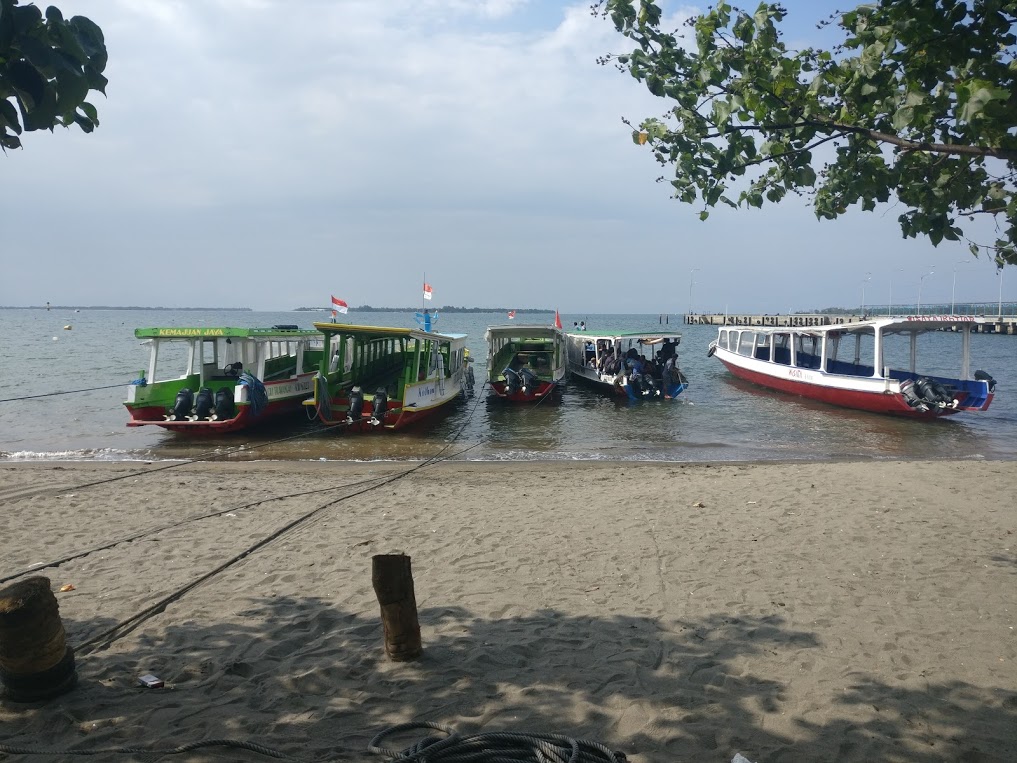
Akumassa
Forum Lenteng is a nonprofit cultural organization based in South Jakarta. It was founded by artists and media activists, including Otty Widasari and Hafiz, in 2003. Today it counts over ninety members. Arkipel, a film festival, held yearly since 2013, shows a rigorous program of documentary and experimental films to an audience of thousands. Milisifilem, the newest initiative, is a pedagogical platform that gives students the tools to deconstruct visual media, and produce images. A shared studio sprawls across the ground floor of the residential house where the most active members live and work. It is a beehive—its door is open twenty-four hours a day.
In 2008, as camera phones became more accessible as consumer commodities, Forum Lenteng started Akumassa. This platform is designed to build media literacy in Indonesia in the wake of the New Order. The deep-rooted censorship of Suharto’s regime, which was intellectually and socially obliterative, encouraged a nationwide divestment in critical thinking. Little has been rectified by the media monopolies that replaced state regulation after the reformarsi in 1998. Grounded in principles of decentralization and collective struggle, Akumassa develops cultural information from the perspective of working people, focussing on film, video, and digital media as tools of grassroots empowerment.
Critical pedagogy is a socially conscious education philosophy that derives from the teachings and writings of the Brazilian educator Paolo Freire. One of its fundamental ideas is concientización. This describes the process of understanding everyday realities from perspectives that can change the oppressive foundations of these realities. It is a mode of transformative action that foregrounds the contributions of the working majority within the social construction of knowledge.
Akumassa—like much of Forum Lenteng’s work, a program of critical pedagogy—has had four distinct phases.
Community workshops, between 2008-12, developed media awareness in numerous small communities across Indonesia.
From 2012-13, the Rekam Media: Community-based Media Watch Program involved ten citizen researchers in ten cities reading two newspapers every week for one year. Media literacy had evolved into media critique. Weekly reports were shared, and at the end of the program, a book was published. Since 2013, Akumassa Bernas has given young writers the chance to produce an essay collection. Sore Kelabu Di Selatan Singkarak, by Albert Rahman Putra, from Komunitas Gubuak Kopi in Solok, West Sumatra, is the first volume published. A collection of writings on tourism is forthcoming from Muhammad Sibawaihi, a member of Pasirputih in Pemenang, Lombok Utara.
In the last decade, the program’s focus has moved beyond media literacy and into social organizing. In this spirit, Akumassa Chronicle supports the production of arts projects. Bangsal Menggawe, a festival initiated by Forum Lenteng with Pasirputih in Pemenang, is the first. It originated in 2016, when it was curated by Widasari with Arief Yudi from the nonprofit Jatiwangi art Factory. This year’s festival, its third rendition, is curated by Widasari and Sibawaihi. Its theme is Museum Dongeng, which, in English, translates to “Museum of Tales.”

Berugaq
In quiet moments, we sit, sleep, or smoke, avoiding rain or sun. Often, I record what happens around me in my notebook or my phone, thinking about detail. Detail is where the soul lives. Detail defies ownership. Words circulate that we’re heading to a field by the Bangsal, where we’re preparing a soccer pitch for the Bangsal Cup. Sharing hands and lungs, we pull out weeds and pick up plastics, which smoulder in a heap at the side of the field. We sit, pick at snacks, and at each other. I think about how “we” is such an operative and elastic pronoun. Later we’re back in our houses or on the berugaq. I think, again, about recording details, and how all I get is these impressions.
through a doorway in lombok utara
cows and rough grasses
converse beyond artists
who doze under pandan hats
there are many ways not to write home
and this is one of them
Museum dongeng
“A story is seen by its listener or reader through a lens. This lens is the secret of narration. In every story the lens is ground anew, ground between the temporal and the timeless,” writes John Berger, the art critic and novelist, invoking Benjamin’s idea of the storyteller who shifts a reader’s perspective.
Stories are subversive when they harbour non-institutionalised forms of knowledge production.
A catalogue, published during the first Bangsal Menggawe, was entitled Eleven Stories from the Southeast. It implies that each contribution to the festival can be thought of as a story. These stories, which take the format of participatory performances, are designed to impel a collective consciousness—a consciousness, in the words of Paolo Freire, “that is understood to have the power to transform reality.”
Having first delayed the festival by some months, last summer’s earthquakes, which caused much destruction in Pemenang and elsewhere in Lombok, and left a lingering, significant trauma, prompt a revised format. Instead of being given money to come and produce artworks, artists are asked to donate their time and labour to a collaboratively-produced, no-budget festival, with the goal of helping Pemenang rebuild. Pasirputih offers volunteers a month of free accommodation and food leading up the daylong festival, which happens on March 2nd. During this preparatory period, a schedule of community-focused activities is conceptualised and realised.
Football has been adored for generations in Pemenang. A field, named Guntur Muda Square, was built, and inter-village matches were often organised. Fights led to this practice lapsing.
The first Bangsal Menggawe revived the football tournament. It was held, then, on the beach, an opportunity not offered by the narrower strip of sand there now. A new field is made nearby, a gift to the city. For the first time, the tournament is for under-13s, signifying the festival’s commitment to the future.
On February 10th, the opening match pits Akas A, a team from Karang Subagan, Pasirputih’s district, against Manyungsang. Akas A make it to the final on March 2nd, but lose a tense, goalless encounter on penalties. The winners are Karla, a team from the neighbouring Karang Langu. They receive a goat. Announcements are made and photos taken, and a convoy of bikes trails the winning team, and their goat, back to their village, honking and cheering under the vertical sun. For those who remain, there is heartache and tears.
Each story contains many stories.
Rudat is a traditional dance. It is local to Lombok, and accompanied by music. Often, dancers sing. Many of its movements, performed by groups of around ten people, derive from silat, a martial art that is indigenous to Southeast Asia. Rudat’s emphasis is on beauty, not aggression. Hands chop, and bodies bend down and spring up. The dance retains little of the speed of silat, but much of its balance and grace.
A video, demonstrating a routine choreographed by Zakaria, a local rudat maestro, is produced and used to teach the dance to classes of school children. A huge crowd—perhaps the entire city—gathers on the beach not long after dawn on the morning of the Menggawe. Children, in multicoloured school uniforms, are orbited by parents and other adults. Together, hundreds of people dance, lead by the example of Menggawe organisers at the head of each column. It is like a huge and ancient K-pop ritual. The youngest children get bored and droop into the sand, where they play. Onlookers drink Lombok coffee while watching, nodding or swaying to the blast of the PA.
That evening, groups of Muslims, Buddhists, and Hindus form praying circles by the water of the Bangsal harbour. Weeks of meetings have de-escalated the city’s existing religious tensions to the point where this is possible. The head of the regency, with the three religious leaders, lights a twelve-foot-tall torch. Its flames eat the night sky. Menakil, an ancient tradition of eating together, happens afterwards. Everyone contributes different foods.
Reviving a principle of democratic exchange, I note that evening. Peace. Kebersamaan. Stability, after the tremors and shakes. There are words in the air.
Stories nourish. Widasari’s curatorial text poetically acknowledges this: “These stories helped us to survive during thirst and hunger when the low tide dried up the hot sand.” An arrangement of small, often unwitnessed acts threaded through Pemenang during one month of collectivised work and dreaming, Bangsal Menggawe: Museum Dongeng germinated modest interventions that are nonetheless the springboards for epistemic movements. Stories nourish, but they are seeds, not foods. Heal the soil. Grow.
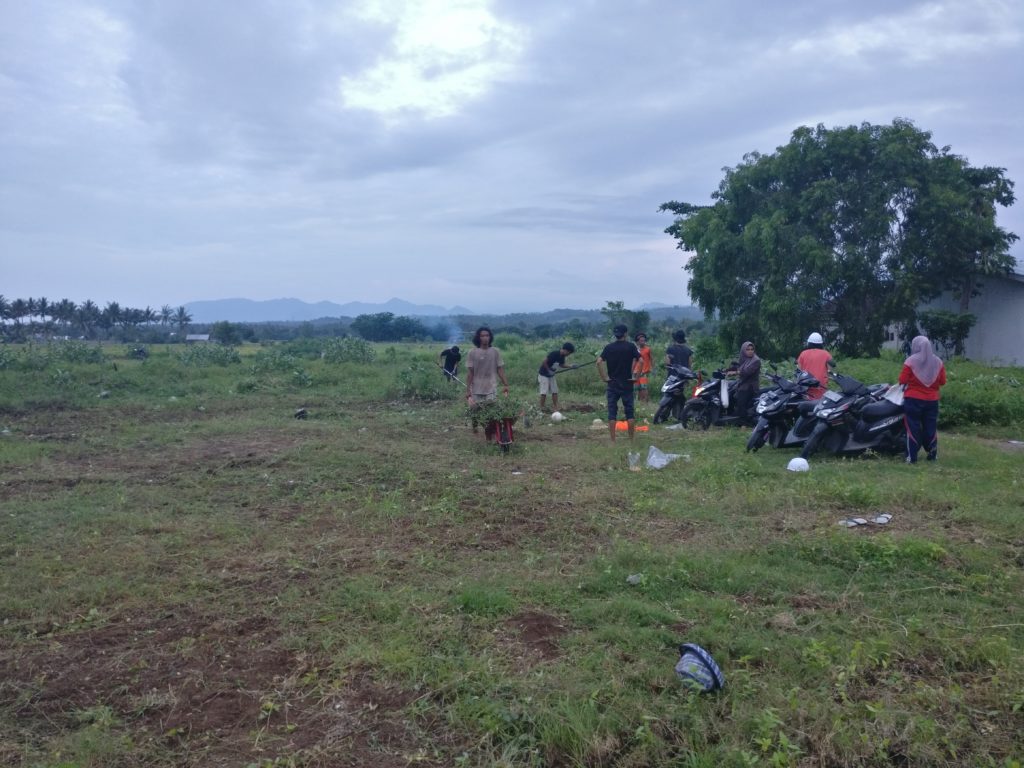
Artists as organizers
Pasirputih, which developed out of Forum Lenteng’s Akumassa program, was founded in the first month of 2010.
Its members, before taking part in the media literacy workshops, had been teachers, students, and scouts. They didn’t train as artists, but the group’s activities increasingly resembled art—Bangsal Menggawe has further encouraged this development, framing these activities as a city-wide celebration. It has revitalised the Bangsal harbour—historically, a cultural centre of Pemenang—as a site of gathering. The Bangsal water, Siba and Gozali together told me, is medicine.
After the earthquakes, Pasirputih relocated to a new plot of land on the edge of Pemenang. Its architecture emphasizes its decentralised operations. A cluster of wooden structures surrounds a central fire pit. You spend time outside as you navigate between the kitchen, the toilet, the berugaq, and the small shelter in which you can sleep or work. There are beds of vegetables and herbs. Ipeh plans to expand these. Pasirputih don’t consider their work to be art or activism, Siba often tells me, as these words aren’t in the vocabulary of most people in Pemenang.
His attitude reminds me of the approach of MTL, a New York-based collective behind initiatives such as G.U.L.F. and Decolonize This Place. “As MTL Collective,” they’ve asserted, “we are engaged in a practice in which the artist’s work does not add only an artistic flair to this or that campaign, but rather contributes research and organizing, aesthetics and action, theory and debriefing and analysis—this entire dialectical process is the art practice. Today, the artist is an organizer, recognizes capitalism has always been hostile to human and non-human life, and understands that people fight where they are.”
The impact of tourism in Pemenang reflects a broader process in which Indonesia, like many places worldwide, is being viciously reconfigured by neoliberal capitalism. This consolidates vast wealth and power in certain cities, gentrifying urban neighborhoods while systematically depriving rural areas. Raquel Rolnik details this process vividly, describing how, “Within the contractual language of finance, territorial ties are reduced to the unidimensionality of their economic value and to the expectations of future revenue streams . . . the expansion of the boundaries of land and housing financialisation goes hand in hand with the increased fragility of other forms of ties to the land, generating a machinery of dispossession.” The fatal resonances of the earthquakes in Lombok are an expression of this machinery. So too are the luxury waterfront real estate developments displacing low-income communities along the north coast of Jakarta.
The fruit of a nearly decade-long collaboration between Forum Lenteng and Pasirputih, Bangsal Menggawe is reimagining traditional values of community empowerment in Lombok Utara following the debilitating impact of the entwined crises of tourism and financialisation. The idea of the artist as an organizer is vital, in this context, because it requires a commitment to de-institutionalisation, in which even the role of the artist is, to a certain extent, disidentified with. This does not negate the possibility of art. Rather, it foregrounds the empathetic, decolonial struggles of recognition, relation, and reciprocation, in a movement beyond the delimited and conventionally valorised work of representation.
Fred Moten, in conversation with Stefano Harney in The Undercommons, has declared, in a similar and exquisite announcement of revolutionary love: “The coalition emerges out of your recognition that it’s fucked up for you, in the same way that we’ve already recognized that it’s fucked up for us. I just need you to recognize that this shit is killing you, too, however much more softly, you stupid motherfucker, you know?”
around the fire at night
mosquitoes bite
thumbs thumble phones
soon Imran will bring tempeh chips
and much laughter
we don’t yet know this
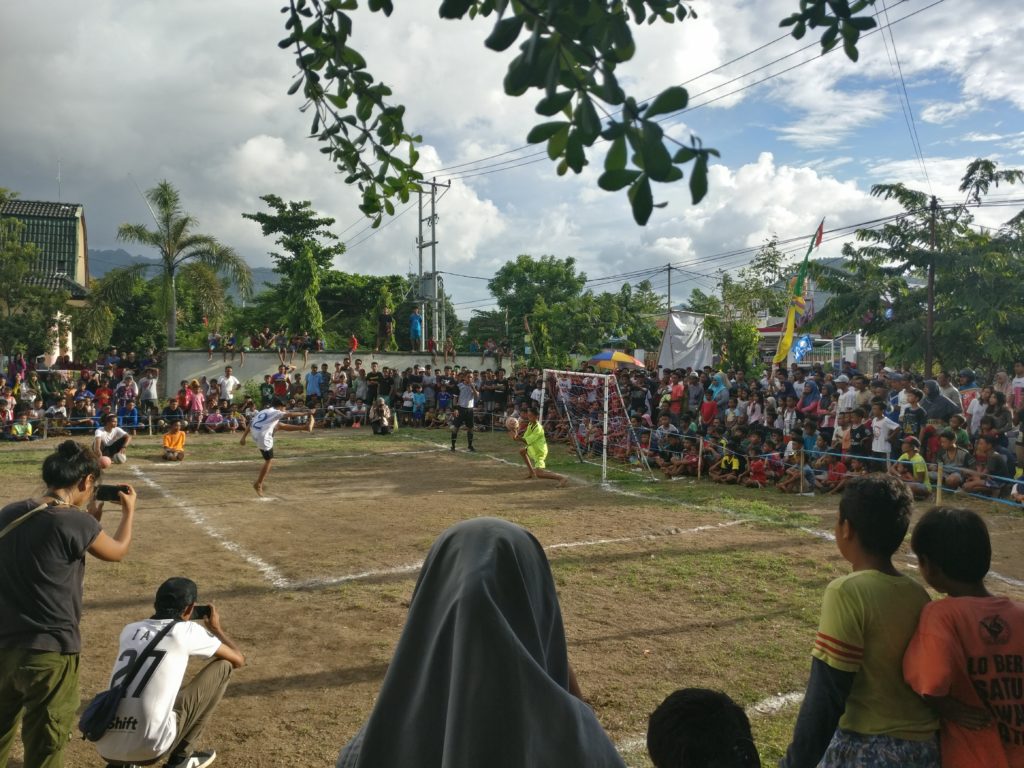

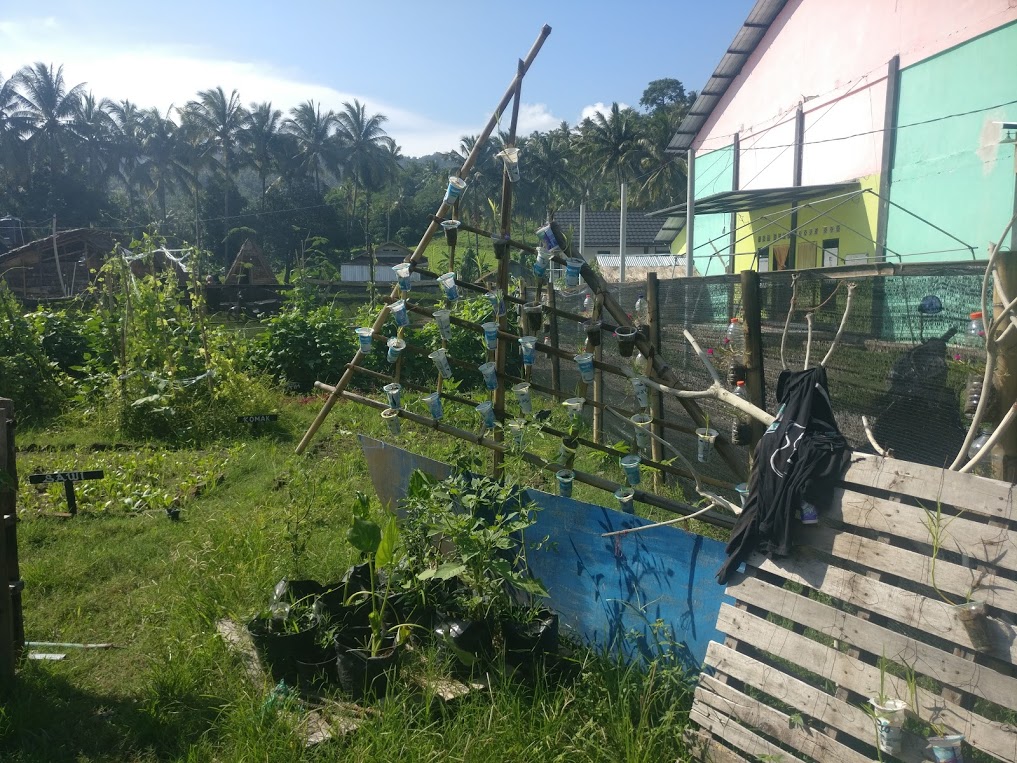
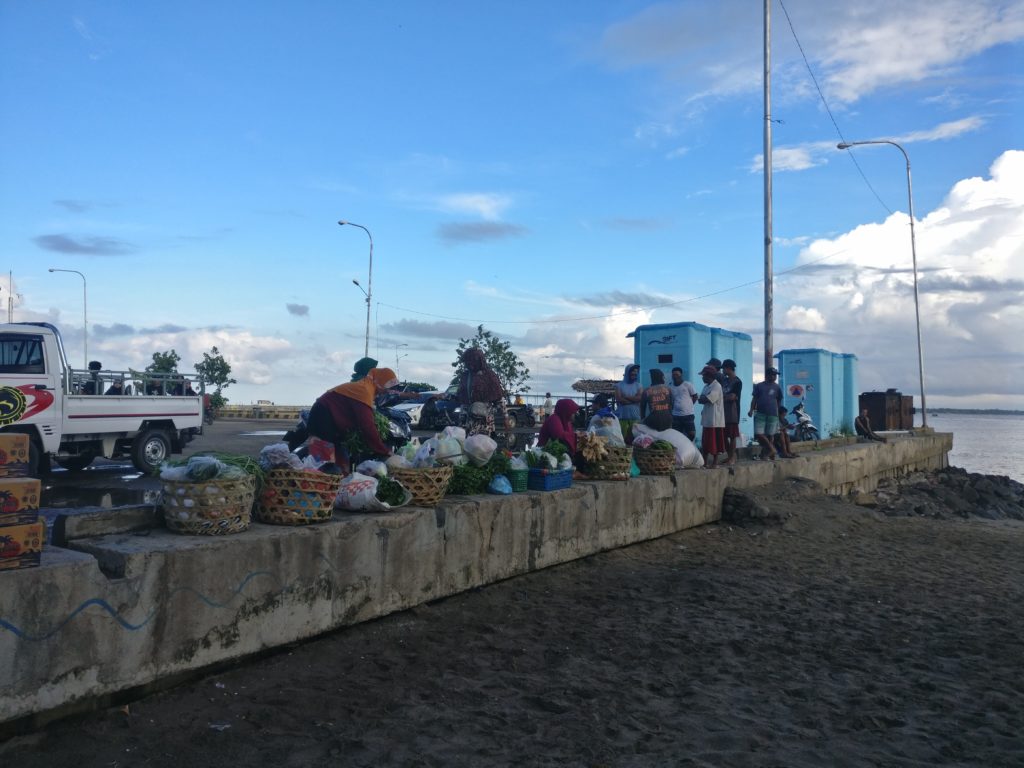
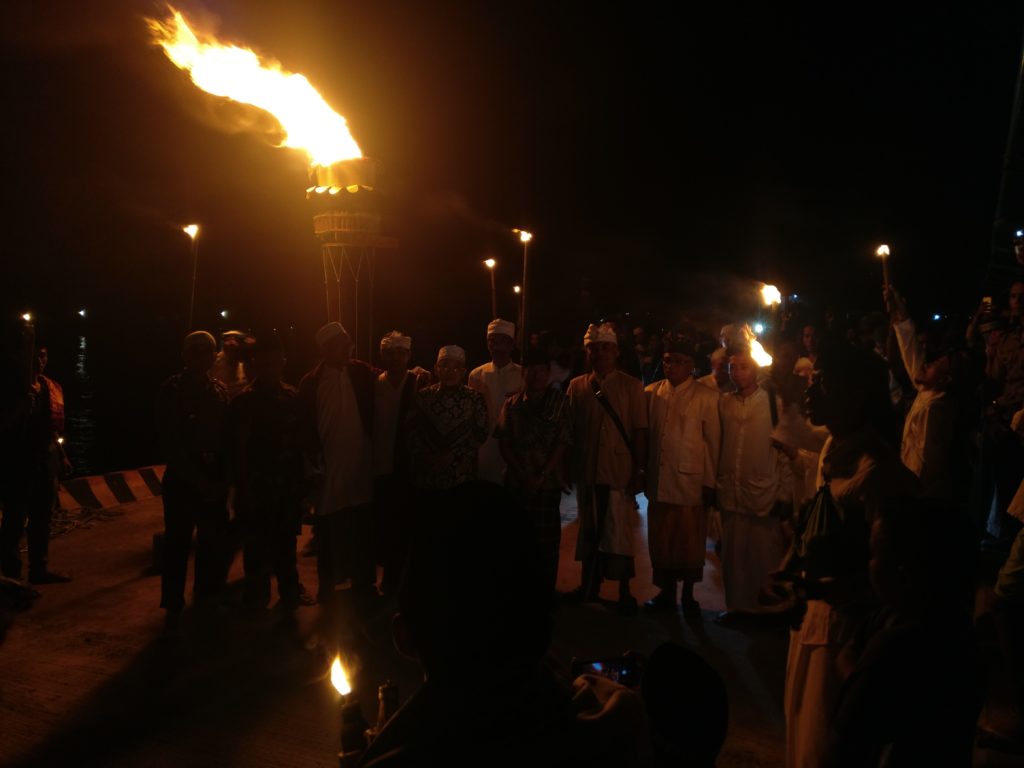
2 Comments